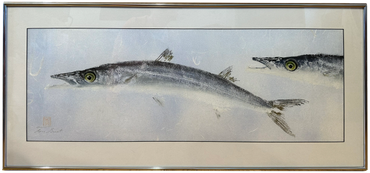
Celebrating 41 years 1984 - 2025 Bringing Your Walls to Life With Our Art
Experiencing problems with this shopping cart email us at geaorders@gmail.com to order.
Signed in as:
filler@godaddy.com

Experiencing problems with this shopping cart email us at geaorders@gmail.com to order.
Sunflower
42.5" x 26"
October 2024
Quilted silk painting
Now in the Frank Klein Collection
https://www.saqa.com/excitement-beginning-art-quilt-collection-frank-klein

The plaques are made from your images and information and they take 4 to 8 weeks to create. See more custom plaque on our Custom Plaque Album for ideas. They are $300.00 plus UPS shipping.
Contact Nancy Giusti to order a custom 16" raku plaque by e-mail nlgiusti@icloud.com or phone 707 442 5249.

We are celebrating 41 years (1984-2025) in business!
Camp Giusti has opened a shopping cart for Tom and Nancy's Raku Ceramics. Our wall pieces are created using the ancient Japanese method of Raku. Each piece is unique, one-of-a-kind, hand-made by Tom and Nancy. Also a Camp Giusti Gallery and Store where your can buy Tom Giusti's Fused Glass and Reproductions of Tom's Gyotaku.

All the ceramic Raku is intended for indoor decor only. Each piece is removed from the kiln when it reaches 1400 degrees Fahrenheit and immediately plunges into a pit of combustible sawdust. The smoke and flame interact with the glaze, creating shimmering metallic colors which enhance the drawn figures and plant impressions.
Thank you for visiting. We invite you to browse through our store and shop with confidence. You can contact us for more information.

Nancy Giusti brings her silk painting to life with silk stitches.
Painted from a photo - The Camera captures the light in a given moment
The dye makes the silk sing
Dancing silk stitches gives the image texture and life.
In the fall of 2017, Nancy took a class from Karen Sistek, a master silk painter at www.karensistekstudio.com, to learn her magic sizing technique of painting silk from an image.
Some of Karen’s students quilted their silk paintings. Nancy Sterett Martin, an award-winning quilt maker, was one of them and gave Nancy the idea to quilt her paintings to give them texture.
Redwood Snag
24" x 47"
Humboldt County, CA
December 2024
Bella, our Bernese Mountain Dog, takes us on a walk every morning in the McKay Community Forest. I just finished my Quilted Silk painting of a Redwood Snag on the Bob Hill Gulch Trail.
If you are interested in a custom quilted silk painting by Nancy from your photo contact Nancy at nlgiusti@icloud.com
Sterling
08/01/15 - 08/26/25
BISS MBVISS BVISSS GCHS JURA'S TRIPLE CROWN IN THE MONEY TKN RN CGC
He was everyone's dog
for Kim and Steve
from Melissa and Barb


Steelhead Salmon
A signed reproduction print of Tom's Gyotaku Steelhead. 20" x 27"
$136.00 plus shipping
To order contact us.

Gyotaku Reproductions
5" x 7" print in a 10" x 12" mat
For each $48.00 plus shipping
For a set of all 5 $200.00 plus shipping
To order Contact us.







Tom catches the life and soul of the fish with his fish rubbings.
Information on Gyotaku
The Japanese Samurai warriors devised the Gyotaku technique in the Tokugawa Era (1600-1868). The Samurai used fish rubbing so they could boast of their fish catch. Black sumi ink was the main medium used to produce their prints. Fish rubbings have also been found in China, believed to be a direct extension of Ancient Chinese stone rubbing. The use of plant life is known as nature printing. It has been found in use in Europe as early as the year 1425.
There are two types of printing most commonly used, Direct and Indirect.
Direct is one of blending ink colors and applying them directly onto a fish that has been carefully prepared. Then a thin sheet of Washi (rice paper) is carefully positioned on top of the inked fish. With one's fingers, the paper's surface is gently rubbed to lift the ink from the fish to the paper, picking up every detail and producing a realistic and dramatic image.
Indirect is done with the same prepared fish. The thin transparent Washi is now dampened and carefully positioned onto the fish. Gently sponging any wrinkles away. This now appears as a second layer of skin on the fish’s surface. Ink is then applied with the use of a tampon (a cotton wad bundled in silk) to form an absorbent ink dauber-type applicator. With the use of many tampons, colors are skillfully applied onto the paper's damp surface until all the details of the underlying fish have been transposed to the surface.
The eye is painted in after, using a brush in both techniques.
Tom Giusti
Born in Boston, Massachusetts, he grew up stalking the elusive fish with pole and tackle and continues the search today in Northern California. “I was just one of those kids that every moment I had free, I would bicycle to the ponds, after school and weekends and go fishing.”
The fish he catches are meticulously prepared for the process of Gyotaku. With fish rubbing, he feels he can catch the life and soul of the fish and retain much of the detail. He is often surprised by what he gets, as each fish he works with is different. But the tactile nature and the physical touch of the dimensions attract him to the process. His creations have a delicate, luminous quality, the pastels enhancing the swimming movement of the fish.
Tom’s background as a machinist, potter, and agriculturalist and his collage studies in fish biology, photography, and ceramics have given him a deep love of nature. A lifetime member of the Nature Printing Society, he has studied with Japanese masters to define his own skills in the ancient art of fish rubbing, Gyotaku.